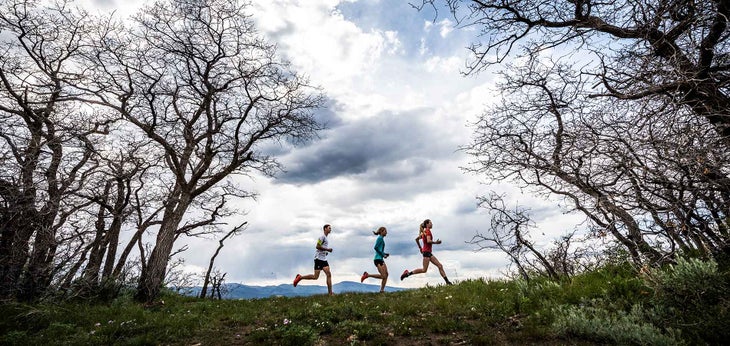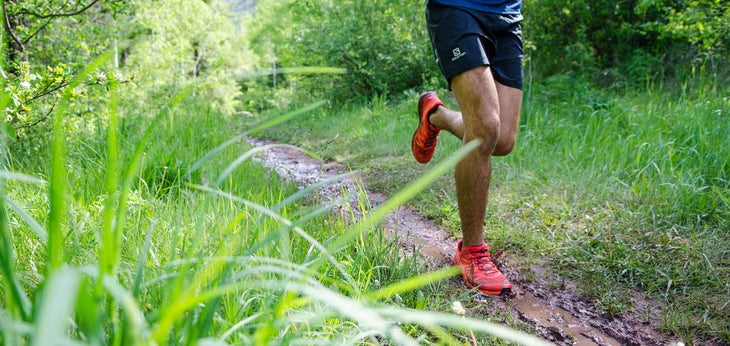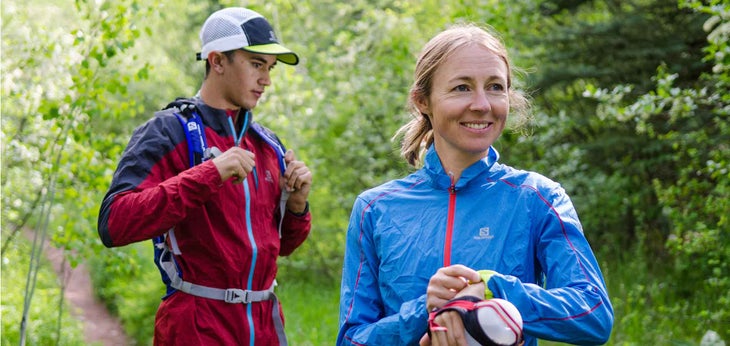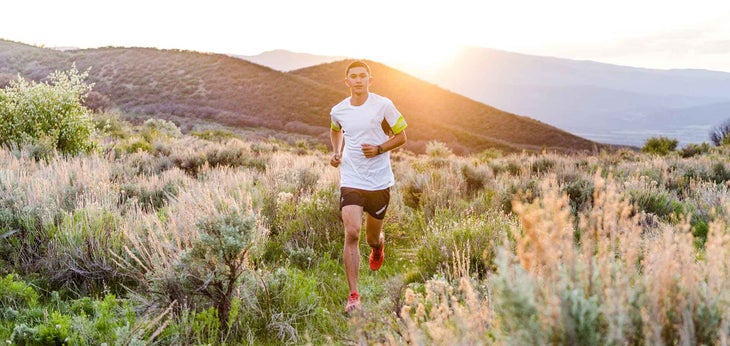New perk! Get after it with local recommendations just for you. Discover nearby events, routes out your door, and hidden gems when you sign up for the Local Running Drop.
Trail running appeals to the outdoorsman or woman in all of us; it’s a means to explore nature’s wonders, be them squeezed into a city or the sort of sweeping mountainscapes that inspire us to buy trail shoes in the first place.
When you’re traveling on foot in the wild, there are some things you can do to make it easier and safer.
NAVIGATI0N
Finding a Trail
Finding a trail is usually as simple as finding some green space. This can be easy if, for example, you live in an area that runs up against mountains or their foothills, with ample nature reserves and public parks.
But it can be more difficult if you’re city-bound and/or in a flat part of the country. In this case, look at a map and seek out anything green—usually there will be some sort of park or preserve somewhere in a metro area, and there will often be trails here.
Even if you have to piece together a partially off-road run, that beats pounding the pavement, in our book.
If you’re in a new place, apps like the Trail Run Project can help you find popular routes in the area.
Basic Map Reading
Trail maps are too variable to give you a definitive tutorial here, but there are a few universally applicable guidelines.
First, make sure you decipher how long a trail, or section of trail, is, and use that to plan your run. Pay particular attention to whether the trail is in multiple sections. Section markers can act as landmarks to help you avoid getting lost.
Second, learn how to decipher topographical markings. The denser, or closer together, the lines are, the steeper the terrain. Identify hills, valleys and peaks so you know what kind of terrain you’re getting into.
Third, learn the map’s color scheme (most trail maps are color-coded). Green often means easiest; black the most difficult.
The Trail Run Project is again a good resource here, as it provides maps and additional data.
Groups
If you’re new to an area—or just new to trail running in a familiar area—there are often trail-running and ultrarunning groups that can act as a conduit as you get into the sport. These groups—often on Facebook—can be full of resources and suggestions for local trails and races.
Take, for example, the dedicated legions belonging to the Upper Midwest Trail Runners, or the Chicago Ultrarunners—two groups thriving in geographic regions where trail options aren’t necessarily obvious. UMTR’s Facebook page is full of questions from people new to the sport, or new to the area, looking for trail and race recommendations; veterans, meanwhile, often advertise their Saturday long run and invite any and all to join.
Bonus: having a veteran show you around a trail can help keep you from getting lost.
Avoid Getting Lost
At the very least, it’s a good idea to carry a map, or even take a photo of a map with your phone (which we know you’re carrying), in case you need to check in. Familiarize yourself with the directions, and carry a compass, or use your phone’s compass app—either way, know how to use and read them before you set out for the first time.
But, If You Get Lost
Hey, it can happen. How to handle losing your way depends a lot on where you are (for example, see below for tips if you find yourself in a serious, exposed situation in the alpine overnight,) but the best rule is to A) not panic, and B) try retracing your steps if it’s a manageable distance.
If it’s too far to safely retrace, your best bet may be to stay put—hunker down for the night if necessary to regroup and head out the next day (see below for how to do this safely, and the gear you’ll want to carry for it), and call for help if possible. If you plan to make regular forays into the backcountry, consider investing in a satellite phone or a SPOT tracker so you can communicate with, and be visible to, your friends in civilization if you’re out of cell-service range.
SAFETY
If you’re headed into the majesty of the high alpine, that’s great! Mountains inspire nearly everyone who sees them and can be a big motivator to getting outside. But real mountains can be particularly harsh and unforgiving. Here are a few of the things you can do to make it a safer and more enjoyable experience.
Even the fittest runners are no match for nature should the wrong turn (or two) of events take place: bad weather, exposure, wildlife or a busted ankle can all render us helpless a long way from the trailhead.
Plan Ahead
Along those lines, making a plan ahead of time before you hit the trails—whether a new or familiar trail system—is wise. It’s good practice to let someone know where you’re going and how long you should be gone, so they can send a search party if needed. But, urge that friend to wait a few hours past your planned return before sending out search and rescue—in the event that you are simply running late, and don’t actually need rescuing.
Weather and Storms
Be aware of weather patterns in the area. In the Rocky Mountains, for instance, it is very common for summer afternoon thunderstorms to hurl rain, hail and lightning above the treeline, so it’s wise to get up high earlier in the day. At the very least, pay close attention and plan to get back down below tree line as fast as possible in case bad weather rolls in.
In colder months—or even in the summer, if you’re up high enough—winter conditions can descend, fast. And it doesn’t take a proper blizzard to make a run miserable or dangerous; whipping winds and freezing rain can bring on hypothermia in a hurry. Be weather aware and gather as much intelligence from locals and people familiar with the mountains before setting out. In addition to checking the forecast, look at the weather radar (various apps are available), which shows the exact path of incoming storms, including size, location, speed and severity.
Gear
Since conditions can change so quickly in the mountains, it’s important to have versatile gear to protect you from unforeseen elements.
Some essentials include: a lightweight wind and water-resistant shell, a long sleeved mid-layer, a headlamp, a small beanie or Buff, lightweight gloves and a lighter. Despite their relatively minimal size and weight, these pieces can all go a long ways to keeping you warm—which is to say they should all fit comfortably in a small pack or even in your pockets and around your waist, depending on your style requirements.
Even in an age where climbers can record their ascent of Everest on Snapchat, there are parts of the world where your phone won’t have service. These happen to be parts of the world trail runners often seek out. If you plan to wander far from civilization frequently, you might want to invest in a form of satellite communication. These devices connect to orbiting satellites rather than earth-bound towers, ensuring far greater coverage in remote areas.
Satellite phones offer most of the same functionality as your mobile phone—you can make calls and send text messages. A personal locator beacon (PLB) is a cheaper option—it has worldwide coverage but can only send out an SOS signal in the event of an emergency. Sitting between those options in both functionality and cost, a satellite messenger device can send messages and an SOS signal, but does not make calls.
First Aid
For longer excursions, particularly with trickier footing where you’re more likely to sustain a twisted ankle or take a nasty fall, carrying some basic first-aid equipment can help get you out of the wilderness and to a real doctor in case you sustain an injury.
Basic bandages—including an elastic cloth bandage (e.g. Ace Bandage), cloth athletic tape and disinfectant wipes should take care of most common trail mishaps. Use the wipes, bandage and tape to clean and dress any wounds you sustain falling.
The bandage and tape will also come in handy in the event of an ankle injury. A busted ankle will require a visit to the doctor to check for a fracture, says Teddy Fagrelius, MD, an Emergency Medical Resident at Johns Hopkins Hospital in Baltimore. But, he adds, getting off the trail safely and urgently with an immobilized ankle should be the priority.
“Most ankle sprains are from inversion injuries, where the ankle is rolled outward, so the focus should be on supporting the outside (lateral) aspect of the ankle,” says Fagrelius. “So, while there are dozens of techniques for taping an ankle, anything that provides strong lateral support in the 90-degree flexed ankle will be appropriate. Auerbach’s Wilderness Medicine provides a good schematic for a weave technique using cloth athletic tape to ‘lock-in’ the ankle at an appropriate 90-degree angle.”
On the trail, he says, an ankle should be taped to minimize pain, limit swelling and maintain a perpendicular angle between the foot and the lower leg.
Hunkering Down
The worst-case scenario could be spending a night outside, stranded due to conditions, injury, or both. In this scenario, it’s important not to panic; but it’s equally important to limit your exposure, and to stay put so as to maximize your chances of being found or making it out the next day under your own power.
Find a modicum of shelter, build a fire, take down some calories and try to get some sleep. Shelter can be as simple as covering yourself with your lightweight shell and some nearby pine needles (or an emergency blanket, if you’ve packed one). Depending on the accouterments nearby, you can get more extravagant: rocks to dig holes, bigger rocks to act as shelter and/or trees on which to build a small roof out of whatever you can find.
It won’t be comfortable, but it’s better to stay put and suffer through the night than to risk getting even more injured by trying to find your way out in the dark.
“It will be uncomfortable, but if you panic and try to find your way out at night, you could get injured or end up in an even worse situation,” says Mike Foote, an accomplished ultrarunner who spends significant time in the Montana backcountry. “Stay calm, and be okay with the fact that it’s going to be an uncomfortable night.”
Above all, he emphasizes: “just don’t make the situation worse by panicking.”
WILDLIFE
The adage goes that animals, for the most part, are more scared of humans than we are of them.
That’s mostly true, and a fact that should lower your anxiety over being eaten on a trail run. But there are exceptions. Mothers can be aggressive if they think you’re threatening their offspring; animals in the throes of scrounging for food might not hear you coming, be startled and react violently; and sometimes, an animal might act out-of-character and decide you’re worth hunting. (They’re wild animals, after all, and we can’t universally predict their behavior).
Those scenarios, particularly the last one, are extremely rare; you’re more likely to be injured or killed driving to the trailhead than consumed by a predator. But knowing how to traipse about another creature’s habitat can nonetheless keep you safer should an encounter occur.
Prevent an Encounter
An ounce of prevention is worth a pound of cure, right? Which is to say, if you take some measures to avoid startling an animal, you’re less likely to have to deal with an agitated mother moose or startled bear.
Know what kinds of animals live where you’re running—Grizzly country requires particular care—and be aware of your surroundings. In addition to all of that, don’t tread lightly. Animals will usually try to avoid an encounter and will scamper if they hear you coming well in advance.
Don’t wear headphones, and pay attention to noises like wind and streams that could make it difficult for animals to hear you coming.
If You Scare an Animal
If they occur, most encounters will still be with animals that would rather not interact with you. Black bears and moose, for instance, probably want their space, and an indication that you’re not a threat. “I calmly talk to them and back off their space,” says Foote, whose Missoula, Montana home base is in Grizzly territory. “That’s always worked. They are almost always just as uninterested in messing with me as I am with them.”
Hostile Animals
Sometimes, animals will take more of an interest in you than you’d like. This can be especially true if you stumble upon a sow and her cubs or calves; it can also be true if you see a mountain lion, whose keen senses likely mean it saw you long before you saw it, and it chose to approach you.
Across the board, if an animal attacks you, use whatever means you can—even a nearby rock—to fight it off; if you can, roll over to protect your vital organs, arteries and face. But first, try to avoid a surprise encounter by making plenty of noise on the trail; with the exception of Grizzly bears, there are typically ways to dissipate the situation without being attacked. But remember that they are wild animals, and even the below tips won’t guarantee a peaceful resolution.
Be preventative by making some noise on the trail; talk with other runners, or even to yourself; sing out loud or shout occasionally. (Don’t listen to headphones.)
Black Bears
If you encounter a black bear, you make yourself bigger; shout and act aggressively. Typically, this will scare the bear off. However, if the bear is with cubs, take the opposite approach: talk calmly, avoid eye contact and back away slowly.
Moose
Moose might be herbivores, but they’re big and can inflict a lot of damage. As Foote indicated above, make it clear you are not a threat; back away slowly, and don’t make any movements that are sudden or could be interpreted as aggression.
Mountain Lions
Cougar encounters can be trickier to navigate, since their keen senses typically mean they saw you long before you saw them; like house cats, they like to stalk. Also like house cats, they can be skittish. Making yourself big and threatening, with lots of shouting, can scare them off; running away will likely lead them to chase you. If you are attacked, fight back. Avoid running alone at dawn or dusk to minimize the chances of an encounter.
Grizzly Country
We’ve made a few mentions of grizzlies occupying a special place on the list of dangerous wildlife. That’s because, where most other animals might back down from a fight with a human, grizzlies seem fully aware of their relative size and strength compared to us, and will more often engage.
That’s not to say grizzlies seek out conflict or encounters. Most incidents with grizzly bears occur when someone startles a bear, or stumbles upon a mother and her cubs. But unlike many other animals, they won’t usually balk if you act aggressively.
POTENTIAL MEDICAL COMPLICATIONS
Running in the mountains—or just out in the elements, whatever the topography—can leave you exposed to some potential weather-related health risks. Here are a few ways to spot the signs, deal with the issue and prevent complications in the first place.
Altitude
Those who have traveled to the mountains from the coasts or the Midwest might be familiar with acute mountain sickness—where your body reacts poorly to the reduced levels of oxygen in a day-long bout of something approaching the flu.
While this can leave as quickly as it comes on, and usually just requires a day of rest, ascending further into the alpine—say, above 10,000 feet—too rapidly can lead to more serious, life-threatening complications:
High-Altitude Pulmonary Edema (HAPE) occurs when fluid fills the lungs and usually hits over 8,200 feet. Signs and symptoms can include difficulty breathing (more than usual), cough, chest congestion, cracking or wheezing while breathing, blue skin color and a rapid heartbeat.
High-Altitude Cerebral Edema (HACE) occurs rarely, in just around one percent of people who ascend over 13,000 feet, but is a very dangerous swelling of the brain. Initial symptoms can mimic those of less-severe mountain sickness, but can progress to confusion, loss of consciousness, intolerance to light (photophobia), extreme fatigue and altered mental state.
HAPE and HACE are both life-threatening conditions caused by ascending to high altitude without sufficient acclimatization. If you or someone you are with experiences symptoms, descend immediately and seek medical attention.
These conditions can be prevented by taking time to acclimatize, which will vary depending on the person. For example, a runner living in Denver (around 5,000 feet above sea level) might be able to climb a 14,000-foot peak on any given day, while a runner who has traveled to Colorado from the Midwest or from sea level might require a couple of days at an altitude at or slightly above that of Denver before ascending the same peak.
Cold
Rapidly changing temperatures (exacerbated by rain or snow) can put you in dire straights quickly. Watch out for a couple of common cold-related ailments when you’re out in the open:
Hypothermia occurs when your body temperature – normally 98.6 degrees Fahrenheit—dips below 95, and is characterized by uncontrollable shivering. You might also have slurred speech or compromised consciousness. Ideally, you should get inside quickly, and layer up until your body temperature is back to normal; but if you can’t, try to stay off the ground and wrap yourself in all available layers until you can get help.
Frostbite occurs when the moisture in your skin freezes; you’ll notice exposed spots turn red, then white and then go numb. Contrary to popular belief, you won’t be able to feel the damage at the time. It is important to get inside as quickly as possible and avoid rubbing the spot, since frozen crystals can cause further damage; use a blow-dryer or warm water to gradually warm the area, without shocking it from getting too hot too quickly.



